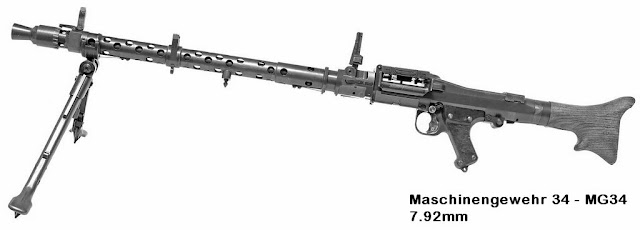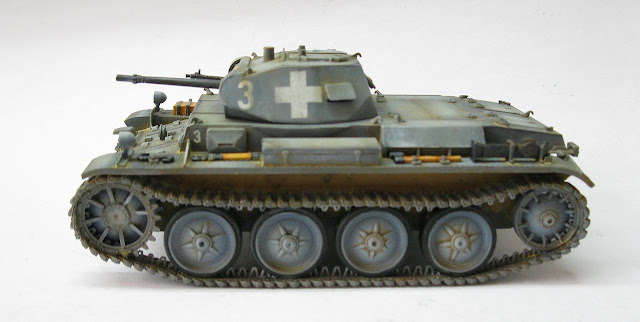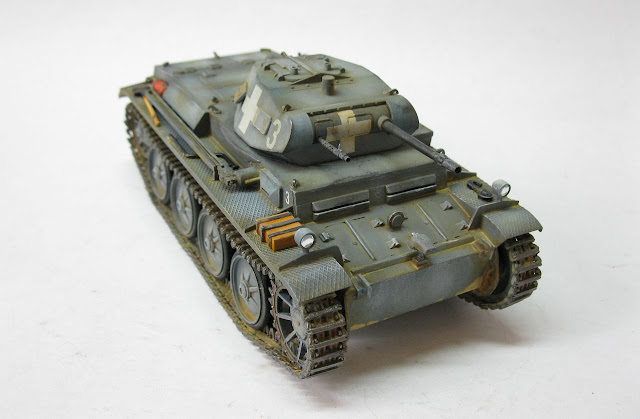Soldaten !!
Now it's time to see something light, fast .... but dangerous: the Panzerkampfwagen II Ausf D - SdKfz 121: the fastest of reconnaissance tanks of Pz II light tanks family.
 |
| Panzer II Ausf D in in a Polish woods. September, 1939. |
The Panzer II is the common name used for a family of German tanks used in World War II. The official German designation was Panzerkampfwagen II (abbreviated PzKpfw II).
Although the vehicle had originally been designed as a stopgap while larger, more advanced tanks were developed, it nonetheless went on to play an important role in the early years of World War II, during the Polish and French campaigns.
The Panzer II was the most numerous tank in the German Panzer divisions beginning with the invasion of France. It was used in both North Africa against the Western Allies and on the Eastern Front against the Soviet Union.
 |
| Pz II Ausf B in Warsaw, 1939. |
 |
| Panzer II with Panzer I in French campaign. |
 |
| Panzer II - Afrika Korps - 1941 |
 |
| Panzer II in the Russian front - Summer , 1941 |
The Panzer II was supplanted by the Panzer III and IV by 1940/1941. By the end of 1942, it had been largely removed from front line service and it was used for training and on secondary fronts. The turrets of the then-obsolete PzKpfw Is and PzKpfw IIs were reused as gun turrets on specially built defensive bunkers, particularly on the Atlantic Wall.
Production of the tank itself ceased by 1943, but its chassis remained in use as the basis of several other armored vehicles, chiefly self-propelled artillery and tank destroyers such as the Wespe and Marder II.
 |
| Panzer II turret - Atlantic Wall - France, 1944 |
Armor:
The Panzer II was designed before the experience of the Spanish Civil War of 1936–39 showed that shell-proof armor was required for tanks to survive on a modern battlefield. Prior to that, armor was designed to stop machine gun fire and high-explosive shell fragments.
The Panzer II A, B, and C had 14 mm of slightly sloped homogenous steel armor on the sides, front, and back, with 10 mm of armor on the top and bottom. Many IIC were later given increased armor in the front of the vehicle. Starting with the D model, the front armor was increased to 30 mm. The Model F had 35 mm front armor and 20 mm side armor. This amount of armor could be penetrated by towed antitank weapons, such as the Soviet 45mm and French canon de 25mm and canon de 47mm.
Armament:
Most tank versions of the Panzer II were armed with a 2 cm KwK 30 L/55 autocannon. Some later versions used the similar 2 cm KwK 38 L/55. This autocannon was based on the 2 cm FlaK 30 anti-aircraft gun, and was capable of firing at a rate of 600 rounds per minute (280 rounds per minute sustained) from 10-round magazines. A total of 180 shells were carried.
The Panzer II also had a 7.92 mm Maschinengewehr 34 machine gun mounted coaxially with the main gun.
The 2 cm autocannon proved to be ineffective against many Allied tanks, and experiments were conducted with a view to replacing it with a 37 mm cannon, but nothing came of this. Prototypes were built with a 50 mm tank gun, but by then the Panzer II had outlived its usefulness as a tank regardless of armament. Greater success was had by replacing the standard 2 cm armor-piercing explosive ammunition with tungsten cored solid ammunition, but due to shortages of tungsten this ammunition was in chronically short supply.
Mobility:
All production versions of the Panzer II were fitted with a 140 PS, gasoline-fuelled six-cylinder Maybach HL 62 TRM engine and ZF transmissions. Models A, B, and C had a top speed of 40 km/h. Models D and E had a torsion bar suspension and a better transmission, giving a top road speed of 55 km/h but the cross country speed was much lower than previous models, so the Model F reverted to the previous leaf spring type suspension. All versions had a range of 200 km.
 |
| Maybach HL 62 TRM 6-Zylinder 140 ps engine font: Panzermuseum Munster - Germany |
Crew:
The Panzer II had a crew of three men. The driver sat in the forward left hull with the gearbox on the right. The commander sat in a seat in the turret, and was responsible for aiming and firing the cannon and co-axial machine gun, while a loader/radio operator sat on the floor of the tank behind the driver. He had a radio on the left and several 20mm ammunition storage bins. In the Panzer II Ausf D, the driver and radio operator sat side by side at the front
Main variants:
Model
|
Production period
|
Number prod.
|
Charac. detail
|
| Ausf a1 | Late 1935 – May 1936 |
10
|
First
model in production
Idler
wheel with rubber
|
| Ausf a2 | May 1936 – February 1937 |
15
|
Idler
wheel without rubber
|
| Ausf a3 | May 1936 – February 1937 |
50
|
Remov.
partion between
fight.
comp. and engine
|
|
|
|||
| Ausf b | February – March 1937 |
25
|
New
engine
Wide
tracks
|
|
|
|||
| Ausf c | 1937 |
1113
|
New
suspension with
quarter
elliptic springs
|
Ausf
A
|
1938-40
|
Anti-bullet
protection in
the
ring turret
|
|
Ausf
B
|
Simplified
technology
much
like previous model
|
||
Ausf
C
|
Improved
armour
Commander
cupola
|
||
|
|
|||
|
|
|||
|
|
|||
| Ausf D | 1938-41 |
138
|
New suspension - faster
New hull
|
| Ausf E | |||
|
|
|||
| Ausf F | 1940-43 |
524
|
Return
to Ausf C suspension
|
|
|
|||
In 1938, Daimler-Benz developed a "Schnellkampfsvagen" (Fast Fighting Vehicle) for the tank battalions of the newly created four Light Divisions. Although the tank mounted the same turret as the standard PzKpfw II Aust. a to F, the hull and superstructure were completely altered. The driver and radio operator sat side by side at the front and each had a sliding shutter visor in the front superstructure plate.
 |
| Panzer II Ausf D in Sd.Ah. 115 trailer tractioned by a Faun L900 Notice the hull of this version. |
A new torsion bar suspension with four large Christie-type road-wheels each side was adopted and the hull and superstructure design owed a lot in general layout. to Daimler-Benz's PzKpfw III. A pre-selector Maybach Variorer VG 102128H gearbox was fitted, with seven forward gears and three reverse; steering was by mechanical clutch and brake. The engine was the Maybach HL 62TRM and could drive the tank at 55 kph; the vehicle could cross a 1.75 metre trench, climb a step of 42 cm and wade up to 85 cm.
The tank's length was 4.64 metres, width 2.3 metres and height 2.02 metres. Armour protection was 30 mm on the front and 14.5 mm on the sides. Only about 138 of these light vehicles were built to the original design in 1938-39, and they were designated PzKpfw II Ausf. D and E. |
| A brand new Panzer II Ausf D, newborn from the factory. |
 |
| Panzer II Ausf D breathing hard on uneven ground. This was his "Achille's Heel" |
 |
| Faul L900 carriying Panzers II Ausf D in a Berlin Parade. Germany, 1938. |
 |
| Faun L900 full loaded with two Panzers II Ausf D. |
 |
| Faun L900 overturned by overload !! The victim was a Panzer II Ausf D. |
 |
| Panzer II Ausf D with PanzerI Ausf B. Notice the early uniform of the crew. |
 |
| Panzer II Ausf D crossing a Polish road. September, 1939. |
 |
| Panzer II Ausf D leading two Panzers I , in an icy landscape in Russia. Winter, 1941-42. |
Flammpanzer II Flamingo / PzKpfw II(F) - Sd. Kfz. 122
Based on the same suspension as the Ausf. D and Ausf. E tank versions, the Flamm (also known as "Flamingo" used a new turret mounting a single MG34 machine gun, and two remotely controlled flamethrowers mounted in small turrets at each front corner of the vehicle. Each flamethrower could cover the front 180° arc, while the turret traversed 360°. The flamethrowers were supplied with 320 litres of fuel and four tanks of compressed nitrogen. The nitrogen tanks were built into armored boxes along each side of the superstructure. Armor was 30 mm to the front and 14.5 mm to the side and rear, although the turret was increased to 20 mm at the sides and rear.
 |
| Flamingo Flamm Panzer SdKfz 122 - Russia, 1941 |
Total weight was 12 tonnes and dimensions were increased to a length of 4.9 m and width of 2.4 m although it was a bit shorter at 1.85 m tall. A FuG2 radio was carried. Two sub-variants existed: the Ausf. A and Ausf. B which differed only in minor suspension components.
 |
| Flamingo Flamm Panzer overloading a Russian rural bridge to its limit. |
One hundred and fifty-five Flamm vehicles were built from January 1940 through March 1942. These were mostly on new chassis, but 43 were converted from Panzer II Ausf. D/E. The Flammpanzer II was deployed in the USSR, but was not very successful due to its limited armor, and survivors were soon withdrawn for conversion to Marder II tank destroyers in December 1941.
After a lack of success with conventional and flame tank variants on the Ausf. D/E chassis, it was decided to use the remaining chassis to mount captured Soviet antitank guns.
 |
| Marder II D in the Russian front. |
The hull and suspension was unmodified from the earlier models, but the superstructure was built up to provide a large, open-topped fighting compartment with a Soviet 76.2 mm antitank gun, which, while not turreted, did have significant traverse. Only developed as an interim solution, the vehicle was clearly too tall and poorly protected, but had a powerful weapon.
 |
| A Marder II D heavily camouflaged - Russia - 1942 |
| Panzerkampfwagen II Ausf D/E | |
|---|---|
| Type | Light fast tank |
| Place of origin | Nazi Germany |
| Service history | |
| In service | 1939–1941 |
| Wars | World War II |
| Production history | |
| Designed | 1938 |
| Produced | 1938–1941 |
| Number built | 138 (excluding conversions) |
| Specifications (Ausf. A-C) | |
| Weight | 10 t |
| Length | 4.64 m |
| Width | 2.3 m |
| Height | 2.02 m |
| Crew | 3 (commander/gunner, driver, loader) |
| Armor | 5– 30 mm |
Main
armament | 1 × 2 cm KwK 30 Ausf. a–F |
Secondary
armament | 1 × 7.92 mm Maschinengewehr 34 |
| Engine | Maybach HL 62TRM 6-cylinderpetrol 140 PS (138 hp, 103 kW) |
| Transmission | 7 speeds forward x 3 reverse |
| Suspension | torsion bars |
Operational
range | 200 km |
| Speed | 55 km/h |
The kit:
For this fast project, in paralel to Faun L900, I choose an old shelf queen: Panzer II Ausf D German Light Tank, from Maquette (#MAQ 3546), the reencarnation of Alan kit.
 |
| My kit: Maquette (#MAQ 3546) |
 |
| The origin: Alan kit (# 009) |
I can almost hear your cry of horror,howling:
"Why you use this piece of crap, for Christ sake ???"
And the candid and simple answer is: Because I have this girl in my closet for years .... and now it's time to bring it to life !!!
I could buy this kit much more modern and detailed ....
 |
| Awesome panzer II Ausf D from Bronco. |
My kits, because I have little space in my apartment ( and have tons of kits...), I keep my models in the bag-kits format, like old ones:
 |
| Old bag-kits in the market.. |
I throw away the boxes of my old kits and keep my girls in bags:
 |
| The panzer II D bagged!! |
 |
| The instructions are, at least, Spartan !!! AHHUUUU!!! |
The chassis and the hull. The little eyebrown in the driver's shield, I intend to remove. Although there is this version with eyebrow, I will make the plain early version. This Maquette kit until it is not so bad ...Good news!!!
 |
| Notice the eyebrown...I'll depilate this girl!!! |
 |
| testing in the Faun... |
 |
| My loved welder...My precious!!! |
 |
| Depilated !!! |
 |
| So nice, for now... |
 |
| Turret time: the gun is good, but the MG...bleargh!!! |
 |
| MG34 by RBModels...Awesome and cheap!!! |
 |
| The fans are hysterical .... |
 |
| The little girl with metal...Much better!! |
 |
| Ready for painting... |
First of all, the markings:
 |
| Primer and shades of gray... |
 |
| With the Faun L900 tank transporter... |
 |
| In close-up... |
 |
| In gloss (Future). ready for decals... Notice the Faun heavy truck |
 |
| Panzerkampfwagen II Ausf D - 3rd Light Division 67th Tank Batallion Polish Campaign - September - October 1939 |
 |
| Starting the weathering... |
 |
| More weathering... |
 |
| Being transported by Faun |
 |
| Tools and headlights... |
And my little girl is ready, finally: Panzerkampfwagen II Ausf D, from 3rd Light Division, 67th Tank Batallion, fighting in the early days of Polish Campaign. September - October,1939.
 |
| Panzerkampfwagen II Ausf D - 3rd Light Division 67th Tank Batallion Polish Campaign - September - October 1939 |
 |
| Panzerkampfwagen II Ausf D with Kojak and Rover, the dog. |
 |
| Panzerkampfwagen II Ausf D with Faun L900 D567 tank transporter |
 |
| Panzerkampfwagen II Ausf D with Faun L900 D567 tank transporter 3rd Light Division 67th Tank Batallion Polish Campaign - September - October 1939 |
Auf Wiedersehen!!



















































Marcos, I'd looked at the model stock your closet ... :-)
ResponderExcluirHi, Stana !!! I'm trying to empty my closet ... But the kits continue to multiply !!!
ResponderExcluirHugs, my friend!!!
Marcos, we have a similar problem with her husband, a small apartment a lot of materials for our hobby. Good Luck...
ResponderExcluir@Stana: Our Big problems: space and time!!!! Kkkkkkkkkkkkkk
ResponderExcluirCheers!!
Não sei se é da foto mas eu achei que eles ficaram um pouco claro.
ResponderExcluir@Henri: Efeito empoeiramento e desgaste, Henri....Um abração e se cuida!!!
ResponderExcluirHi.
ResponderExcluirQuality workmanship is again.
Often happen that when trying to reduce, the work to increase
The time and volume are limited
Superb work as ever, just goes to show an old kit can be just as good as a new one!
ResponderExcluirThanks a lot, Pete. Hugs, my friend!!
Excluir